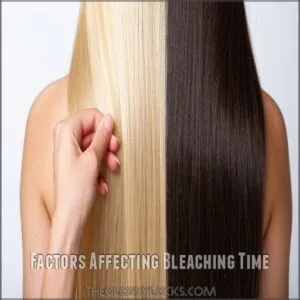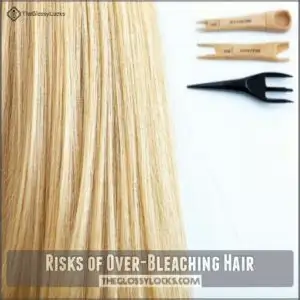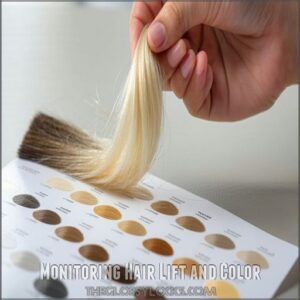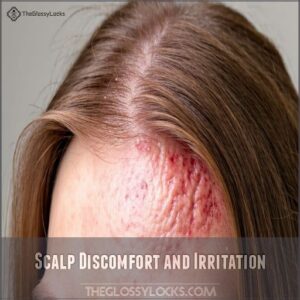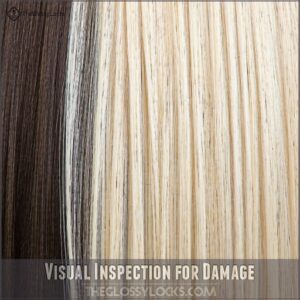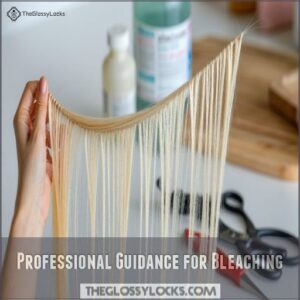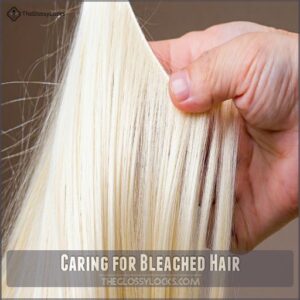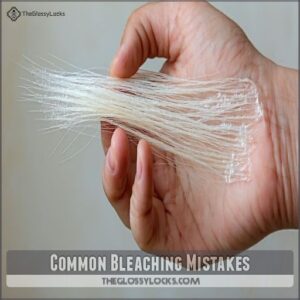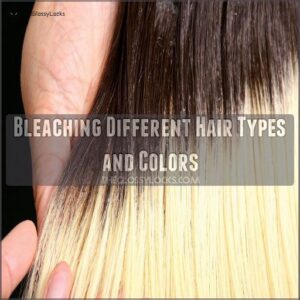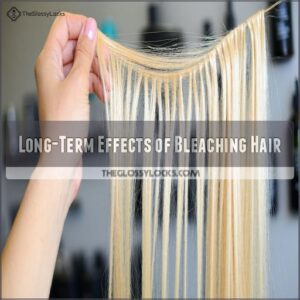This site is supported by our readers. We may earn a commission, at no cost to you, if you purchase through links.
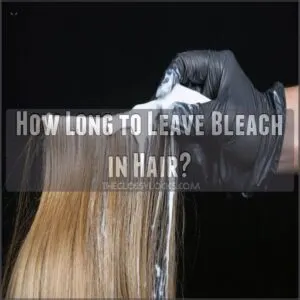
But here’s the kicker—different hair types and developer strengths can shift this timeline.
Fine or light hair might need less time, while darker hair could require the full 30 minutes.
Be careful not to exceed this, though, or you risk turning those lovely locks into straw!
Use a lower volume developer if you’re cautious about damage.
Always keep an eye on the color change and consider doing a strand test.
Who knew bleaching required so much finesse?
There’s more to explore beyond these basics.
Table Of Contents
- Key Takeaways
- Factors Affecting Bleaching Time
- How Long to Leave Bleach in Hair
- Bleaching Time Based on Developer Volume
- Risks of Over-Bleaching Hair
- Recognizing Over-Bleaching Signs
- Best Practices for Safe Bleaching
- Caring for Bleached Hair
- Common Bleaching Mistakes
- Bleaching Different Hair Types and Colors
- Long-Term Effects of Bleaching Hair
- Frequently Asked Questions (FAQs)
- How long should you leave bleach in your hair?
- How can I keep my hair from becoming white?
- How long does bleach take to lighten hair?
- How long should you leave bleached hair after dyeing?
- How long should a hair color be bleached?
- How long should you wait before bleaching your hair?
- How long do you let bleach sit on hair?
- How long do you leave 20 volume developer on?
- How do you know when bleach is done processing?
- Does leaving bleach in longer make your hair lighter?
- What products help repair bleached hair?
- How often can you bleach hair safely?
- Can bleach cause scalp sensitivity long-term?
- Does diet affect hairs bleaching response?
- Is it safe to bleach hair during pregnancy?
- Conclusion
Key Takeaways
- Keep an eye on your hair during bleaching, checking every 10 minutes to avoid damage and achieve the desired shade without over-processing.
- Use the correct developer volume based on your hair type and color goal; a stronger developer works faster but can lead to more damage.
- Always perform a strand test before fully bleaching to predict results and minimize risks of excessive damage.
- After bleaching, follow a strong hair care routine, including deep conditioning and regular trims, to maintain hair health and color vibrancy.
Factors Affecting Bleaching Time
When bleaching your hair, several factors determine how long you should leave the bleach on.
From your hair type and starting color to your desired shade and the developer you use, each element plays a key role in achieving the perfect lift without damaging your locks.
Hair Type and Bleaching Time
When you’re thinking about bleaching hair, you’ve gotta consider its type.
Fine hair needs less time to bleach than thick hair.
If you’re dealing with thick hair, you can find specific products like those found on websites selling bleach for thick hair here for thick locks.
Here’s why this matters:
- Fine Hair: Bleaches quicker, so keep the watch on speed dial.
- Thick Hair: Needs patience; apply longer.
- Natural Hair: Responds differently; test frequency to avoid damage.
Starting Hair Color and Bleaching Time
Your starting hair color plays a big role in how long you should leave bleach in.
Dark hair needs more time than light hair to reach those blonde ambitions.
Virgin hair responds differently than colored hair—consider it as a blank canvas.
Multiple bleaching sessions might be necessary for desired results.
| Starting Color | Bleach Time | Sessions Needed |
|---|---|---|
| Dark | Longer | Multiple |
| Light | Shorter | Few |
| Virgin | Variable | May Vary |
| Colored | Longer | Often Multiple |
| Gray/White | Shorter | Minimal |
Desired Hair Outcome and Bleaching Time
Chasing your ideal hair goals influences bleach time. A subtle lift? You might spend less time relaxing with a magazine. Eyeing a major change? You’ll need more patience.
Keep these tips in mind:
- Assess current hair color
- Know your desired level
- Consider hair health
- Avoid rushing
- Always perform a strand test
These steps help make the process go smoothly.
Type of Developer and Bleaching Time
Developer concentration is your compass for bleaching success.
Higher volumes mean stronger bleach strength but less processing time.
For a gentle approach, 10 volume works with patience.
With 40 volume, expect faster results, perfect for dramatic color lift.
Always tailor your choice to hair type and desired outcome, balancing speed with safety to keep your hair vibrant and healthy.
Bleaching Frequency and Time
Striking a balance between bleaching and time can be tricky. After choosing the right developer, focus on bleaching frequency:
- Monitor Hair Damage: If you spot breakage, reduce frequency.
- Hair Type Impact: Understanding your hair’s unique characteristics, such as its porosity and elasticity, is crucial for determining the right bleaching frequency. Fine hair requires less frequent bleaching.
- Safe Bleaching: Allow hair recovery between sessions.
- Color Change: Drastic changes demand more care—space out sessions wisely.
How Long to Leave Bleach in Hair
So, you’re ready to lighten your locks? Awesome! But how long should you leave that bleach in? Knowing this is key to avoiding a hair-raising disaster. Several things affect bleaching time.
- Your hair’s thickness and texture play a huge role. Think of it like cooking – thinner noodles are done faster than thicker ones.
- Your natural hair color matters too. Darker hair needs more time, while lighter hair needs less.
- How light you want to go influences bleaching time. A subtle change is quicker than a dramatic transformation.
- Bleaching frequency is important. Your hair needs a break! Over-bleaching leads to damage.
Remember, patience is a virtue, especially when bleaching. Start with shorter intervals, checking frequently, and stop when you achieve your desired lightness. Always follow the instructions on your bleach product. Ignoring this advice can lead to serious hair damage. Safety first!
Bleaching Time Based on Developer Volume
Choosing the right developer volume is essential for bleaching your hair without turning it into a cautionary tale.
Understanding the color wheel, particularly how to balance undertones for a harmonious look using the hair color wheel, is crucial in achieving desired results. Knowing how long to leave each developer in will help you achieve the perfect shade while keeping your hair healthy and vibrant.
40 Volume Developer Bleaching Time
When you’re using a 40 volume developer, timing is everything, and it’s also important to follow the recommended bleach-to-developer ratio, such as 1 part bleach and 2 parts developer.
Keep it on your hair for a maximum of 20 minutes to avoid frying your locks.
This high-strength formula works fast, giving you dramatic lift.
But be careful—it’s not suitable for all hair types.
Explore 40 volume developer alternatives if you’re worried about safety and potential damage.
30 Volume Developer Bleaching Time
Wondering how long to leave that 30 volume developer in your hair? Here’s a quick breakdown:
- Hair Type Matters: Thicker hair might need closer to 30 minutes, while finer hair could be done sooner. To minimize damage, you should factor in the ratio of bleach to developer based on your hair type and desired results.
- Color Lift Expectations: Looking for lighter results? Extend up to 30 minutes.
- Risk of Damage: Exceeding 30 minutes increases damage potential, so keep it in check!
20 Volume Developer Bleaching Time
Thinking about using a 20 volume developer? You’ve got options. It’s a bit more versatile, lifting hair 2-3 shades lighter.
You can leave it in for 20 to 40 minutes, perfect for those subtle shifts in color.
Remember to follow the proper mixing ratios, such as the standard 8 parts peroxide to 1 part powder lightener for developer and bleach mixing.
Just keep your hair type, starting color, and desired outcome in mind.
Best practices remind you to watch for damage, ensuring your mane stays magnificent.
10 Volume Developer Bleaching Time
Using a 10 volume developer might feel like waiting for water to boil.
It works slowly, so you can leave it on for up to 45 minutes.
For gentler alternatives, consider a bleach bath recipe that uses lower volumes of hydrogen peroxide or developer.
This gentler approach minimizes bleach damage, making it ideal for minor hair color changes.
Keep an eye on your hair and have a steady hair care routine to maintain its health.
50 Volume Developer Bleaching Time
Jumping from the smoother 10 volume to a 50 volume developer isn’t for the faint-hearted.
It’s not just risky, as seen with using 10 volume developer.
Legality becomes a concern, and you’d better leave it to professionals.
Leaving it in for over ten minutes can spell disaster for your hair.
Here’s why:
- Safety Precautions need respect.
- Using box dye with harsh chemicalscan lead to hair damage like brittle hair, such as when using bleach, which can further increase the Hair Damage Risk skyrockets.
- Alternative Options might save your tresses.
Risks of Over-Bleaching Hair
Over-bleaching can seriously damage your hair, leading to breakage and dryness.
You could also experience color loss, making your hair brittle and prone to damage, so it’s essential to follow the instructions carefully.
Hair Damage and Breakage
Bleaching can be like walking a tightrope—too much, and your hair pays the price.
Hair breakage becomes a real concern, turning healthy strands into brittle wires.
Preventing hair breakage is key.
Follow bleaching guidelines, and embrace gentle care routines afterward.
Strengthen your hair with nourishing treatments.
The goal?
Keep those strands from snapping and maintain their natural strength.
Color Loss and Melanin Depletion
Too much bleaching can zap your hair of melanin, leading to a color crisis.
Picture blonde hair turning into an unwanted white surprise.
Melanin loss strips away natural pigment, making bleached hair appear dull and less vibrant.
Remember, once the color’s gone, it’s not easy to get back.
Manage your bleaching to maintain that rich, lively hue.
Hair Porosity and Moisture Loss
Over-bleaching drains the life out of your hair, leaving it as porous as a sponge with moisture slipping away like a secret.
This loss of porosity disrupts the moisture balance, turning your locks brittle.
To combat this, indulge in deep conditioning treatments, nurturing your hair back to health.
Remember, maintaining hair health is key for damage prevention and vibrant strands!
Dehydration and Hair Shaft Damage
Everyone wants hydrated, smooth hair, but bleach can leave it parched and fragile.
Without enough moisture, the hair shaft takes a hit, leading to split ends and snapping like a brittle twig.
To keep your strands safe, hydrate religiously—think masks and oils.
Trust your instincts; if your hair feels dry, it’s time to amp up the care routine.
Keratin Loss and Hair Brittleness
When your hair feels like straw after bleaching, keratin loss might be the culprit.
It’s the protein that keeps your strands strong and elastic.
Without it, hair brittleness creeps in quickly.
Here’s how to combat this:
- Keratin supplements can fortify.
- Opt for hair protein treatments regularly.
- Use damaged hair repair formulas.
- Apply hair breakage prevention techniques.
Recognizing Over-Bleaching Signs
Recognizing when you’ve over-bleached your hair can save you from major hair regrets.
Keep an eye out for things like unexpected dryness, breakage, or that unwanted hay-like texture, and don’t hesitate to ask a professional for advice.
Monitoring Hair Lift and Color
So, you’ve avoided major hair damage.
Now, let’s talk about watching your hair’s color change.
Use a color chart as a guide for your desired tone.
Regular checks, maybe every 10 minutes, are key.
Compare your strands to the chart to see if you’re getting close.
Remember, a strand test beforehand is your best friend!
This helps you accurately gauge timing intervals and avoid over-processing.
Scalp Discomfort and Irritation
How do you know when your scalp’s calling for help? During bleaching, pay attention to any discomfort. That tingle shouldn’t feel like a bonfire.
Here’s how to handle and prevent irritation:
- Check for allergies: Patch test products to spot bleach allergies.
- Use soothing products: Look for aloe-based creams.
- Prevent irritation: Apply oils as a protective barrier.
Visual Inspection for Damage
To avoid hair damage during bleaching, keep an eagle eye on the process.
Split ends, dryness, or a change in color and texture are red flags.
Using harsh products like sodium chloride shampoo can make your hair prone to damage, think of your hair’s health like a houseplant: if it looks brittle or limp, it’s time to stop.
Checking every 10 minutes can help prevent unwanted surprises and keep your hair in excellent shape.
Professional Guidance for Bleaching
When checking for bleach damage, think of this as troubleshooting your hair’s vibe.
Sometimes, though, consulting a pro is like having a GPS for color correction.
You’ll better grasp:
- At-home vs. salon: Know the limits.
- Strand test as a GPS: Navigate damage before it happens.
- Color consultation: Prevent disaster with pro insights.
Best Practices for Safe Bleaching
When bleaching your hair, it’s important to keep a few best practices in mind to avoid turning your locks into a frizzy nightmare.
Select the right developer volume for your hair type.
Protect your scalp with a barrier cream.
Consider professional help if you’re unsure.
Limiting Bleaching Time
Spotting the signs of over-bleaching helps you manage time wisely. Don’t push it longer than 45 minutes.
Bleaching frequency matters, so give your hair a break between sessions.
Watch your hair’s condition; if it feels like straw, you’ve gone too far.
Use the strand test religiously and always seek professional advice to keep your hair healthy.
Choosing Suitable Developer Volume
Choosing the right developer volume’s like picking the perfect spice level for your chili.
Match the developer volume to your hair type and desired lift:
- 10 Volume: For slight color change, little lift.
- 20 Volume: Ideal for several shades lighter.
- 30 Volume: Significant lift for dark bases.
- 40 Volume: For bold, bright results—use cautiously!
Protecting Scalp From Irritation
Before you bleach, protect your scalp!
A little pre-bleaching prep goes a long way.
Apply a barrier cream or petroleum jelly to prevent irritation.
Think of it as a shield against potential scalp sensitivity.
This simple step helps make for a more comfortable bleaching experience.
Remember post-bleach care is also important for healthy hair.
Professional Assistance for Bleaching
You’ve got the right idea protecting your scalp.
Next up, think about professional assistance for bleaching. Here’s why it pays off:
- Color Consultation: Get the perfect shade every time.
Don’t forget to stock up on the right bleach hair products for your needs, like those available at bleach hair solutions.
- Hair Health: Professionals minimize damage.
- Damage Prevention: Stylists know safe techniques.
- Stylist Recommendations: Personalized advice guarantees salon safety.
Let experts handle it so you don’t have to worry!
Caring for Bleached Hair
You’ve just taken the plunge and bleached your hair, so taking good care of it now is essential to keep it looking vibrant.
Moisturizing treatments, especially for those with Type 1C hair textures, and regular conditioning are key to keeping your hair nourished and avoiding the dreaded fried hair look.
Post-Bleaching Hair Care Routine
After bleaching, your hair craves the TLC of a customized routine.
Deep conditioning is your go-to damage repair strategy—think of it as a spa day for tired tresses.
Add a color refresh to keep your hue vibrant and use heat protection religiously to ward off further damage.
This routine locks in hydration, ensuring your hair stays glowing and healthy.
Moisturizing and Nourishing Bleached Hair
When your hair feels like straw, deep conditioning becomes your best friend.
Sink into a ritual of hair masks and oil treatments to revive those parched strands.
With each session, you’ll notice improved moisture retention.
Let hydration tips be your guide, ensuring those delicate locks soak in the nourishment they desperately need.
Your mane will thank you!
Protecting Bleached Hair From Damage
Bleached hair craves protection like your favorite cozy sweater on a cold day.
Shield it from further damage with some savvy tricks:
- Deep conditioning: Keep those strands nourished and happy.
- Cold water rinse: Lock in moisture and shine.
- Heat protection: Before styling, always use it!
- Color-safe products: Preserve your vibrant hue longer.
Regular Trims for Bleached Hair
Grabbing those scissors might seem intimidating, but regular trims keep bleached hair thriving.
Trimming every six to eight weeks can help fend off split ends and maintain hair health.
Picture it as shedding unnecessary baggage; your tresses stay fresh and light.
Regular salon visits also prevent breakage, protecting your crowning glory.
Prioritize trims to keep your bleached hair in top shape!
Common Bleaching Mistakes
Let’s face it, bleaching your hair at home can be tricky!
Avoiding common mistakes like leaving bleach in too long or using the wrong developer will help you achieve gorgeous, healthy-looking results.
Leaving Bleach on for Too Long
Taking care of bleached hair’s all good until you leave bleach on too long. Imagine your hair becoming straw—yikes! Here’s what happens if you overcook it:
- Hair damage and breakage becomes real.
- Color loss ruins your vibrant look.
- Scalp irritation leaves you sore.
Keep an eye on that clock!
Using Incorrect Developer Volume
Using the wrong developer volume can zap your desired hair color and trigger safety risks.
If you go too high, it’s like taking a sledgehammer to your hair—it’ll bleach faster but risk major hair damage.
Opt for a lower volume for gentle lightening, preserving your hair’s integrity.
The right choice aligns with your color outcome, maintaining hair health.
Not Performing Strand Test
You’ve considered Developer Choice, but skipping the strand test can lead to major Bleaching Mistakes.
It’s like driving blindfolded; you won’t see how your hair reacts until it’s too late.
A quick strand test helps you dodge Hair Damage Risks by previewing results, especially when working with Developer Dilution Ratios to achieve desired color intensity without compromising hair health.
Think of it as a sneak peek, ensuring Home Bleaching Safety and reducing the need for Professional Help later.
Not Following Product Instructions
Skipping product instructions can turn your bleaching session into a hair-raising tale of woe.
You’ll end up with:
- Bleach damage: Brittle, broken strands that nobody wants.
- Scalp irritation: Itching, burning discomfort that could be avoided.
- Color inconsistency: Unexpected hues that leave you looking like an art project gone wrong.
Stick to the instructions—your hair will thank you!
Bleaching Different Hair Types and Colors
In terms of bleaching, each hair type and color demands its own special treatment.
Whether you’re working with dark brunette or light blonde, knowing how to approach your specific hair type can save you from unexpected surprises.
Bleaching Virgin Hair
Bleaching virgin hair isn’t as tricky as you might think.
Starting with untouched locks gives you a clean slate with no risk of unexpected old dye reactions.
Always remember a strand test is your best friend—it helps you gauge bleach damage and color lift.
Don’t skip the toner; it’s essential for perfecting that desired shade and maintaining your fresh look.
Bleaching Colored or Treated Hair
Already colored or treated hair needs extra care.
Previous color can affect bleaching time and results.
Expect longer processing, maybe multiple sessions.
Watch for color fading or damage risks.
A strand test is key, before you commit.
Consider color correction with toner afterward.
Remember, less is more with bleaching frequency to avoid unnecessary damage.
Bleaching Different Hair Textures
When you’re tackling different hair textures—fine hair and coarse hair—adjust your bleaching time carefully.
Fine hair often bleaches quicker, so keep an eye out to prevent hair damage.
Coarse hair, being stubborn, might require a bit longer.
The texture impacts how bleach penetrates, so your approach varies—just like finding the right spice level for each dish.
Bleaching Roots and Regrowth
Got hair roots peeking through like mischievous squirrels?
Tackle root touch-ups by applying bleach precisely at the regrowth line.
Aim for seamless regrowth blending rather than harsh lines.
Consider root shadowing for a natural fade.
Color correction keeps things harmonious.
Remember, bleach works quicker on roots; monitor closely to avoid surprises and keep your root maintenance game strong.
Long-Term Effects of Bleaching Hair
Bleaching your hair can feel like a fun adventure, but it might come with a bit of a price tag for your hair’s health.
Over time, you could notice your hair becoming more fragile, less vibrant, and a touch too crispy for comfort.
Permanent Damage to Hair Structure
Bleaching can sneakily alter your hair’s structure, weakening strands from the inside out.
Imagine your hair as a skyscraper with its support beams gradually eroding—protein loss leaves it fragile and prone to thinning.
This affects texture and how well your hair holds color, leaving it less vibrant over time as its beauty fades.
Increased Risk of Breakage and Split Ends
You’ve made it past the initial damage, but unfortunately, the risks don’t stop there.
Repeated bleaching increases the risk of breakage and split ends, making your hair brittle and prone to snapping.
Think of it like a fraying rope – the more stress it’s under, the more likely it’s to snap.
Color Fade and Loss of Vibrancy
Sadly, bleached hair often fades.
To fight this, use color-safe shampoos and conditioners.
Regular toner use keeps brassiness at bay.
Hair glossing or color refreshers can also help maintain vibrancy.
Think of them as little pick-me-ups for your hair color!
These products are your secret weapons against dullness.
Protect your investment and keep your gorgeous color shining.
Dryness and Brittleness of Bleached Hair
If your bleached hair feels like straw, dehydration’s the culprit.
Color fade might be annoying, but dryness and brittleness are even bigger headaches.
Keep your hair happy and healthy with a solid care routine.
Think hair masks and deep conditioning to lock in moisture.
Avoid heat styling and try protein treatments.
With a little love, your hair can thrive again.
Frequently Asked Questions (FAQs)
How long should you leave bleach in your hair?
Leave bleach in your hair for 20 to 40 minutes, depending on developer volume and hair type.
Check hair every 10 minutes to avoid damage like brittleness or dehydration.
Consider professional guidance for best results.
How can I keep my hair from becoming white?
Avoid your hair turning white by not over-bleaching.
Stick to product instructions, monitor color change every 10 minutes, and aim for gradual lightening over multiple sessions.
Consider using a low-volume developer and moisturizing treatments.
How long does bleach take to lighten hair?
Lightening your hair with bleach? The time depends on your hair’s type and color, and the desired shade.
Generally, it takes between 15 and 45 minutes, but always follow product instructions.
Patience is key; rushing can damage your locks.
How long should you leave bleached hair after dyeing?
After dyeing bleached hair, don’t wash it for at least 48 hours.
This gives the color time to settle, locking it in more effectively.
Your new hue will last longer and look more vibrant.
How long should a hair color be bleached?
Curious how long to bleach your hair?
Stay vigilant: 40-volume needs 20 minutes max, while 20-volume lasts 20-40 minutes.
Always check product guidelines and monitor your hair closely for signs of damage or discomfort.
How long should you wait before bleaching your hair?
Before bleaching your hair again, give it at least three to four weeks to recover.
This waiting period helps minimize damage.
Allowing natural oils to restore moisture and protect your hair from becoming overly brittle.
How long do you let bleach sit on hair?
Wondering how long to bleach your hair?
It depends on the developer volume.
For example, use 30 volume for 15-30 minutes.
Always follow the product’s instructions, check every 10 minutes, and consult a professional to avoid damage.
How long do you leave 20 volume developer on?
Leave the 20 volume developer on for 20 to 40 minutes.
Keep in mind that finer hair or lighter shades require less time.
Regularly check your hair’s condition and follow instructions to prevent over-bleaching or damage.
How do you know when bleach is done processing?
You see the magic happen when your hair reaches the desired shade.
Inspect every 10 minutes, watching for too much lift or dryness.
If it feels straw-like or looks overly bright, it’s time to rinse.
Does leaving bleach in longer make your hair lighter?
No, leaving bleach in longer doesn’t guarantee lighter hair. It’ll likely just damage it. Follow product instructions; over-processing is a bad idea. Your hair’s health is important!
What products help repair bleached hair?
Ever feel like your hair’s crying for help after bleaching?
Repair it with nourishing products like keratin treatments, deep conditioners, and leave-in masks.
They strengthen your strands, restore moisture, and help regain your hair’s natural shine.
How often can you bleach hair safely?
Bleaching hair frequently can wreak havoc on your strands.
A safe bet is to wait at least 4-6 weeks between sessions to give your hair some much-needed recovery time, ensuring it stays healthy and damage-free.
Can bleach cause scalp sensitivity long-term?
Imagine your scalp as a delicate flower; over time, frequent bleaching might make it less resilient.
You might notice increased sensitivity, itching, or burning sensations.
Regularly nourishing your scalp can help mitigate long-term sensitivity.
Does diet affect hairs bleaching response?
Your diet can impact hair’s bleaching response.
Poor nutrition results in weaker hair that bleaches unevenly.
A balanced diet with ample proteins and vitamins supports stronger hair, enhancing uniform color lift during the bleaching process.
Is it safe to bleach hair during pregnancy?
It’s generally advised to avoid bleaching your hair during pregnancy due to potential chemical exposure risks.
If you’re considering it, consult a healthcare provider first for personalized advice to guarantee both your and your baby’s safety.
Conclusion
So, you’ve conquered the mysteries of how long to leave bleach in hair.
Remember, patience is key! Don’t rush the process; you wouldn’t want to end up looking like a startled flamingo.
Knowing your hair type and using the right developer are essential for achieving that perfect shade.
Always do a strand test—it’s your best friend against a hair-raising disaster.
Mastering how long to leave bleach in hair takes practice, but the results are worth it.
Happy bleaching!

